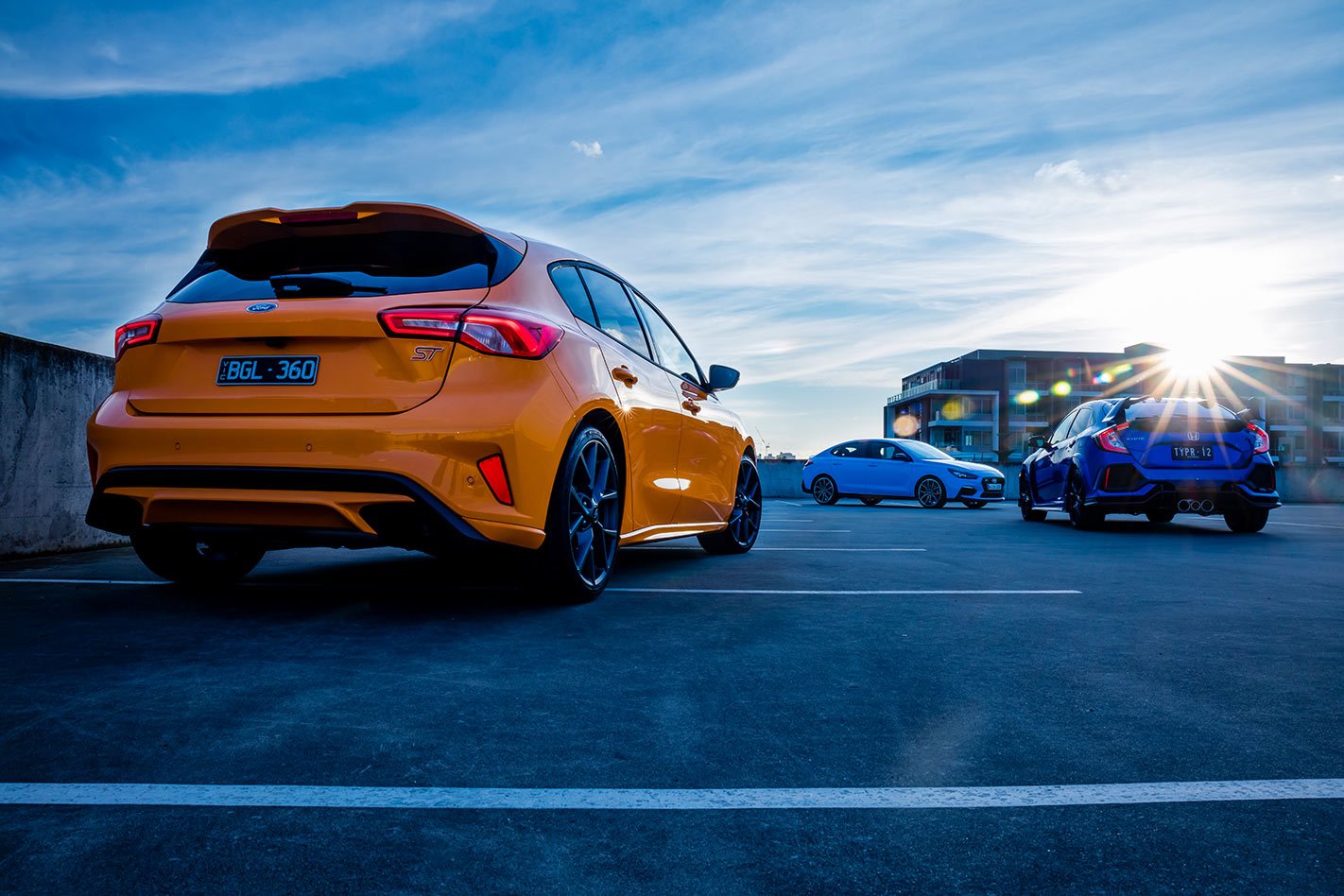There’s something magical about 206kW. No, really. Translated to horsepower it’s 276, or 280PS if you prefer. This was Paul Rosche’s target for the M1, BMW’s first and only mid-engined supercar. It’s the claimed power output of the Nissan Skyline GT-R and the original Honda NSX and if it was enough for Ayrton Senna to fling around Suzuka wearing white socks and loafers, it’s probably ample for a five-door Ford Focus hatchback.
This ST version of the latest Focus has some big loafers to fill. There’s no fire-breathing all-wheel-drive RS version of this generation Focus planned, so the ST now has to serve as the sports flagship, bumping power up notably from the last model’s 184kW output. But where that car was a $39K deal, the latest Focus ST jumps up in price to $44,690, placing it right into the crosshairs of some far more serious tackle. We’ve lined up two of the very finest. The last time we put the Honda Civic Type R up against the Hyundai i30N was in April 2018, when the then-box-fresh Hyundai astounded everyone by just pipping the Civic – an almost unbackable pre-event favourite – for top spot in our 12-car hot hatch megatest.
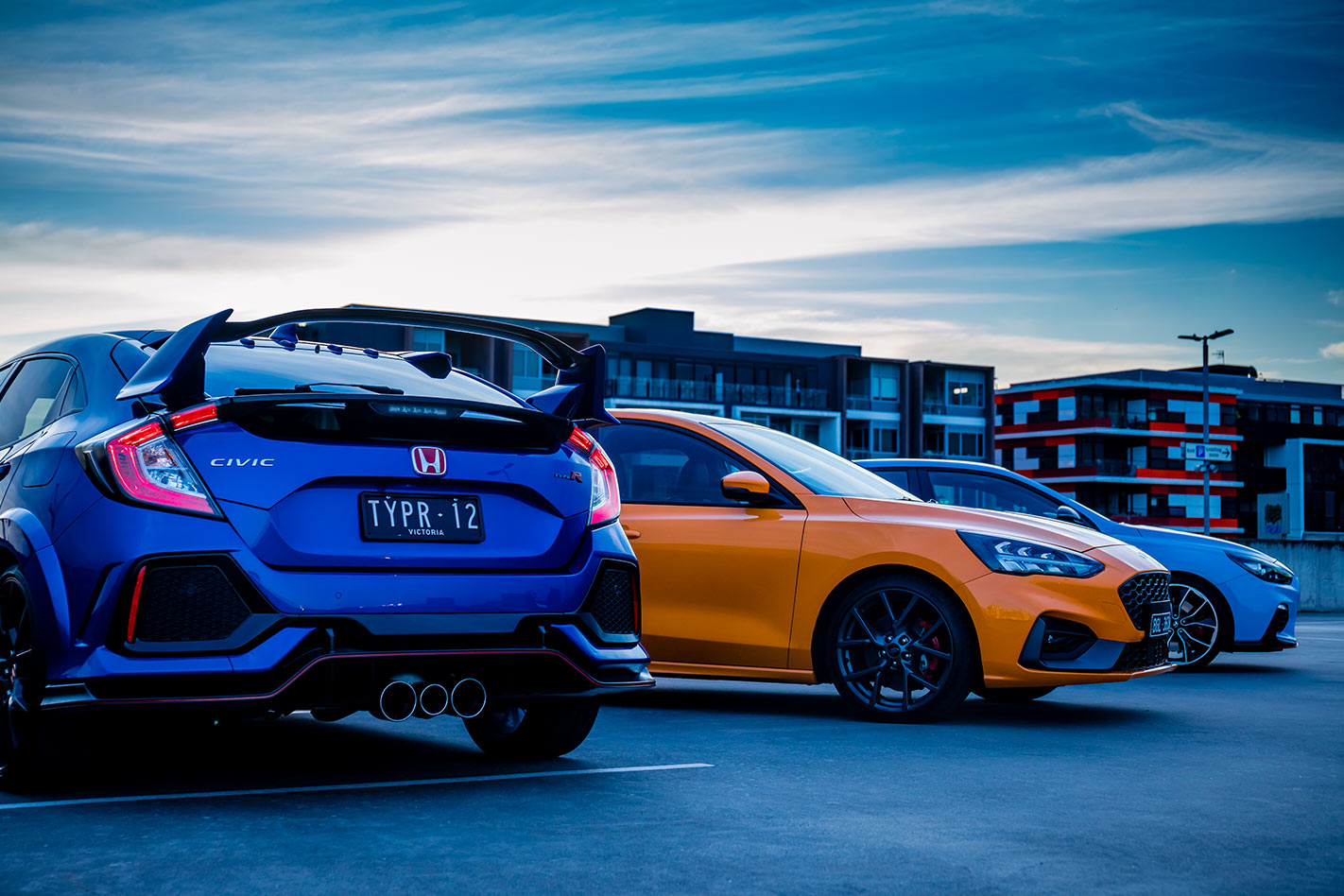
While the Civic hasn’t changed a great deal from then, with the asking price still an identical $50,990, the i30N has spawned the Fastback version we’re testing here, along with an Australian-tune for its suspension and a five-year warranty that includes track usage. That sounds like a lot of car to beat for the most modest asking price of this trio at $42,910.
It’s also the car with the lowest power and torque figures, as testing at a cold and damp Heathcote dragstrip indicated. With 202kW and 353Nm at its disposal, the Hyundai, a six-speed manual front driver like both of its assembled rivals, still has trouble deploying drive cleanly. On its best run, the Vbox flashes up 6.3 seconds to 100km/h and 400m broken in 14.3 seconds at 161km/h. The Ford’s 2.3-litre four is a far torquier unit than the Hyundai’s Theta II lump. The standard-fit launch control proved functionally useless on the day, resulting in manic axle tramp and wheelspin, but the Ford’s ability to flat-shift without lifting off the gas helps it to 100km/h in 6.1 seconds and 400m in 14.2 seconds at 164km/h.

Then the Honda rolls to the line and puts some manners on both its rivals. Clearly having 228kW at its elbow helps here, but it’s still 20Nm down on torque compared to the gutsy Ford. Nevertheless, once the Conti tyres had warmed through a little, it jets to 100km/h in 6.0 seconds flat and on to 400m in 13.8 seconds at a terminal speed of 170.2km/h. That 400m time, incidentally, is exactly the same as what the original NSX achieved. How’s that for symmetry? On a warmer, drier day we’d have doubtless gone quicker but the Ford manages to land an early blow on the defending champ. Time to head for the hills.
Can we talk about the Civic Type R for a moment? You’ll probably have noticed that it has grown significantly from its compact FK2 predecessor. And how that car was nothing like its blobby, torsion-beamed FN2 Type R forebear? And how that one looked alien to the multi-link suspended EP3 before it? There is no continuity of development here. Every generation seems to start from a clean sheet. Both good and bad elements are ditched and Honda seems to exhibit a corporate amnesia, unable to extract any benefit from considered model development.
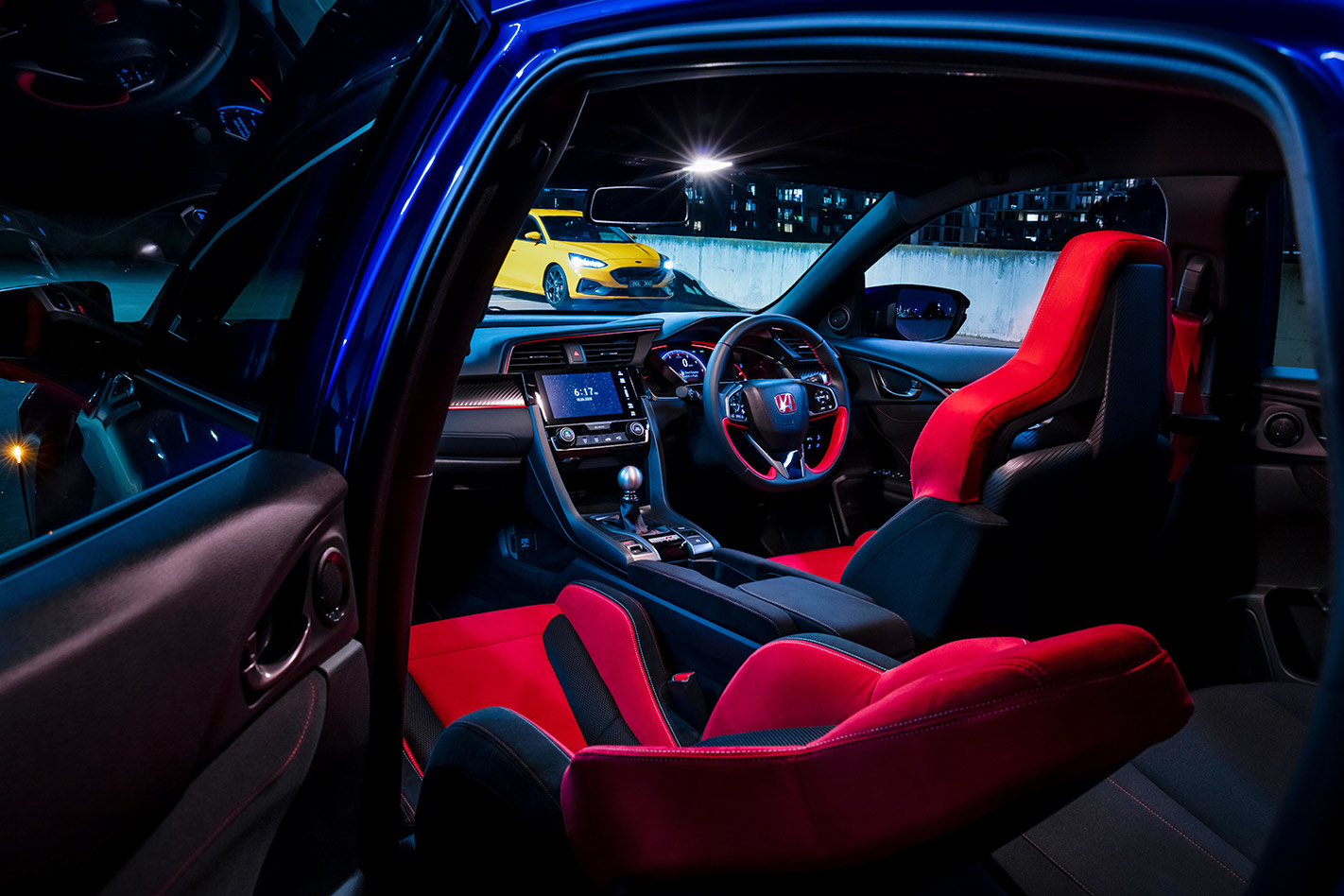
The reason is that the engineering genius has long resided in a business called the Honda R&D Company. It runs as its own entity, conceives and develops vehicles, and presents another firm, the Honda Motor Company, with the finished product. Its job is to sell whatever it receives. The marketing people and brand experts live here. You can doubtless see the problem with this silo approach already, but from April of this year, that has changed. The R&D Company has been brought under the same roof, so to speak, with one senior suit in charge of authoring a sensible model ‘story’, much like virtually every other car company out there. That could mean less extreme Hondas but it could also spell a coherent development path for what is, right now, the world’s most focused front-drive hot hatch. And it could benefit from that.
There’s something unsettling about the intensity of the Civic Type R. I’m minded of this as it powers through the forest hairpins outside of Healesville. It’s in its element here, making the Hyundai seem numb and the Focus lumpen. It’s god-like at ten-tenths, the low cowl, low seat, and slick dual-pinion variable-ratio steering allowing you to position the car perfectly. It feels exotic in a way denied the other pair and just so relentlessly urgent. Every fibre of the Type R goads you into driving it harder, to stalk around hill routes, to harass Porsche drivers, filling their rear-view mirrors with its exquisitely ungainly maw.
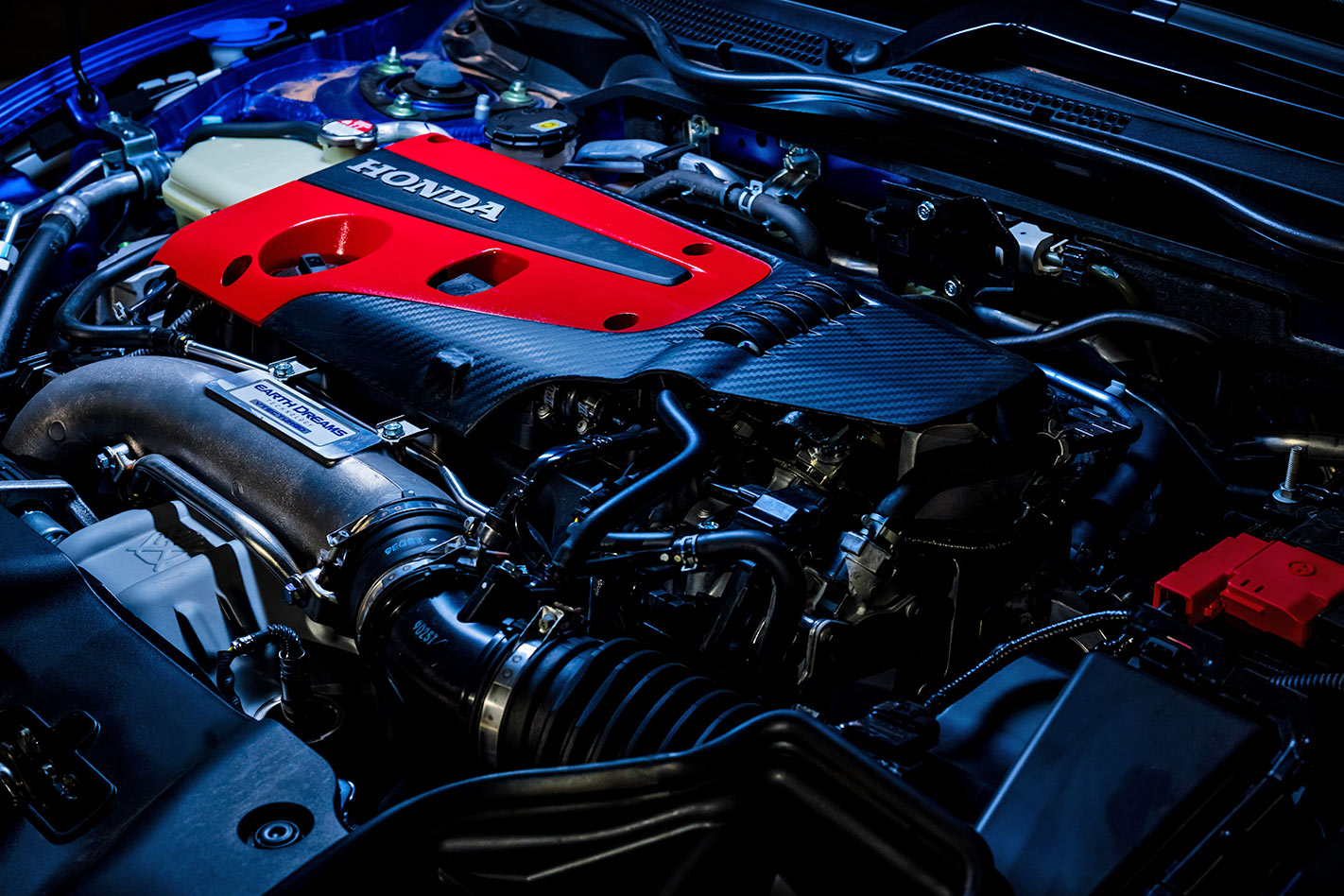
Power pours in between 2500 and 6000rpm, each gearshift bringing a bird-like chirp as the turbo bleeds off excess boost. Body control is excellent across the camber of the road, and while the brake pedal feel is initially a little vague, it firms up nicely just in the right height in the pedal arc for clean heel and toes. In order for the Civic to make sense you need to live in a cosy section of several interlinking Venn circles. You need to be willing to pay 25 percent more than the Hyundai for a couple of points of extra composure. You’re required to be willing to put up with its sophomoric styling excesses, its klutzy cabin ergonomics, its four seats rather than five. You’ll pay extra for bigger 20-inch tyres and more expensive insurance. But you’ll do that because you want the angriest, most dynamically gifted front-drive hot-hatch on the market.
You’ll choose the Type R for the same reasons 911 GT3 owners don’t want a 911 Carrera – because dynamic excellence matters to you. That it also delivers the best damping suppleness of this trio only underscores the fact that the engineers at Honda R&D Co are chassis alchemists. Let’s hope that never changes.
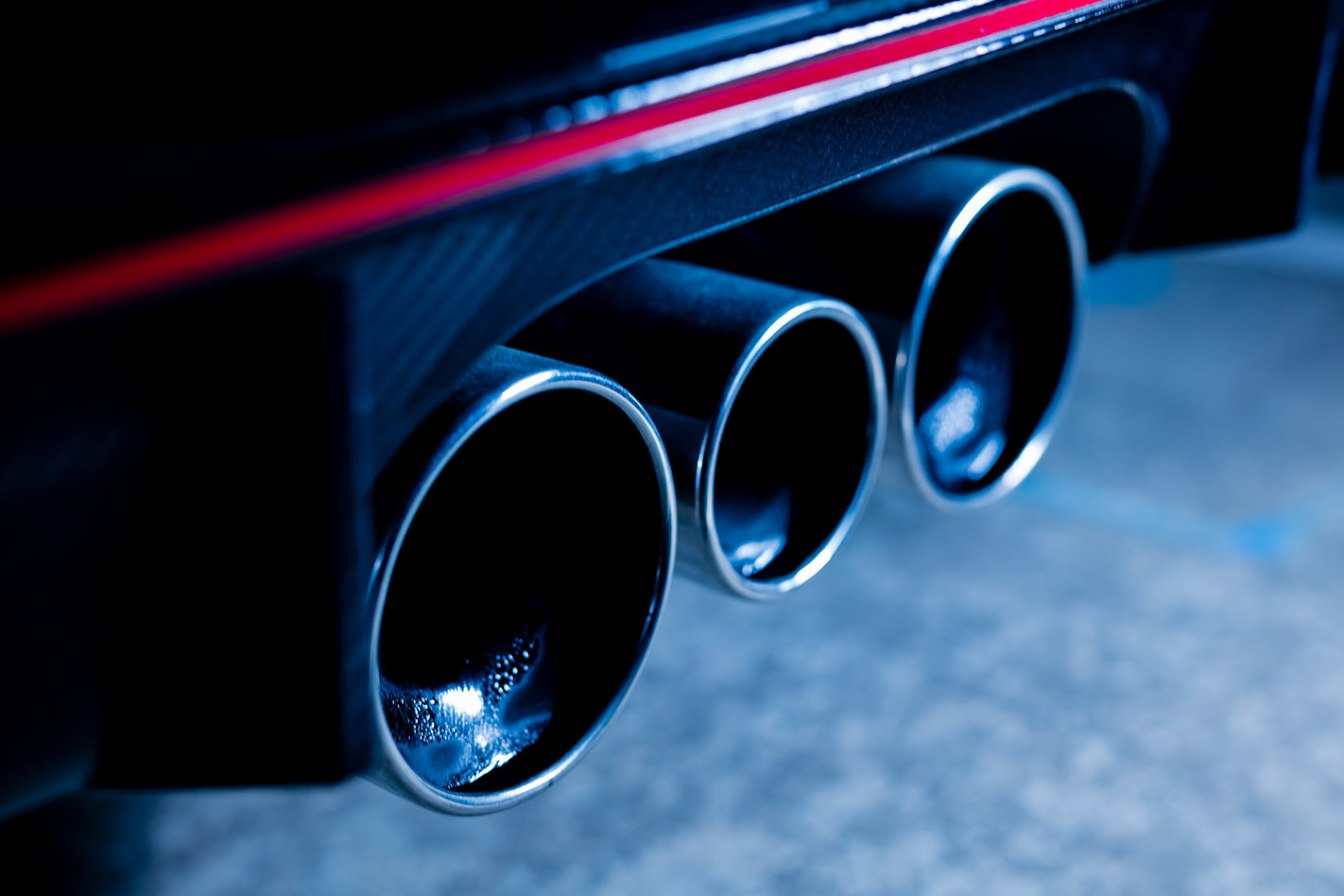
If the Civic is the standard of handling brilliance by which the others are judged, the Hyundai i30N pushes it very close. After the Civic, the Korean car feels no less muscular, but the steering lacks the initial bite on turn-in, the ride is slightly more abrupt and your centre of gravity feels a little more elevated. What the engine lacks in aural drama, Albert Biermann’s team at Hyundai has compensated with an exhaust system that sounds a fusillade of bangs and crackles on the overrun. As Cam Kirby discovered during our late night photoshoot, it’s genuinely naughty in a multi-storey car park or a city tunnel.
Would I choose the Fastback over the cheaper i30N hatch? Probably not. You lose a bit of rear headroom, rear visibility through the slot-like window isn’t as good and, on a shamelessly subjective basis, I don’t think it’s as pretty. I reckon most would be quite happy to put the $1500 saved towards a set of trackday rubber to help get the best from Hyundai’s circuit-friendly warranty. The hatch simply offers better bang for your buck.
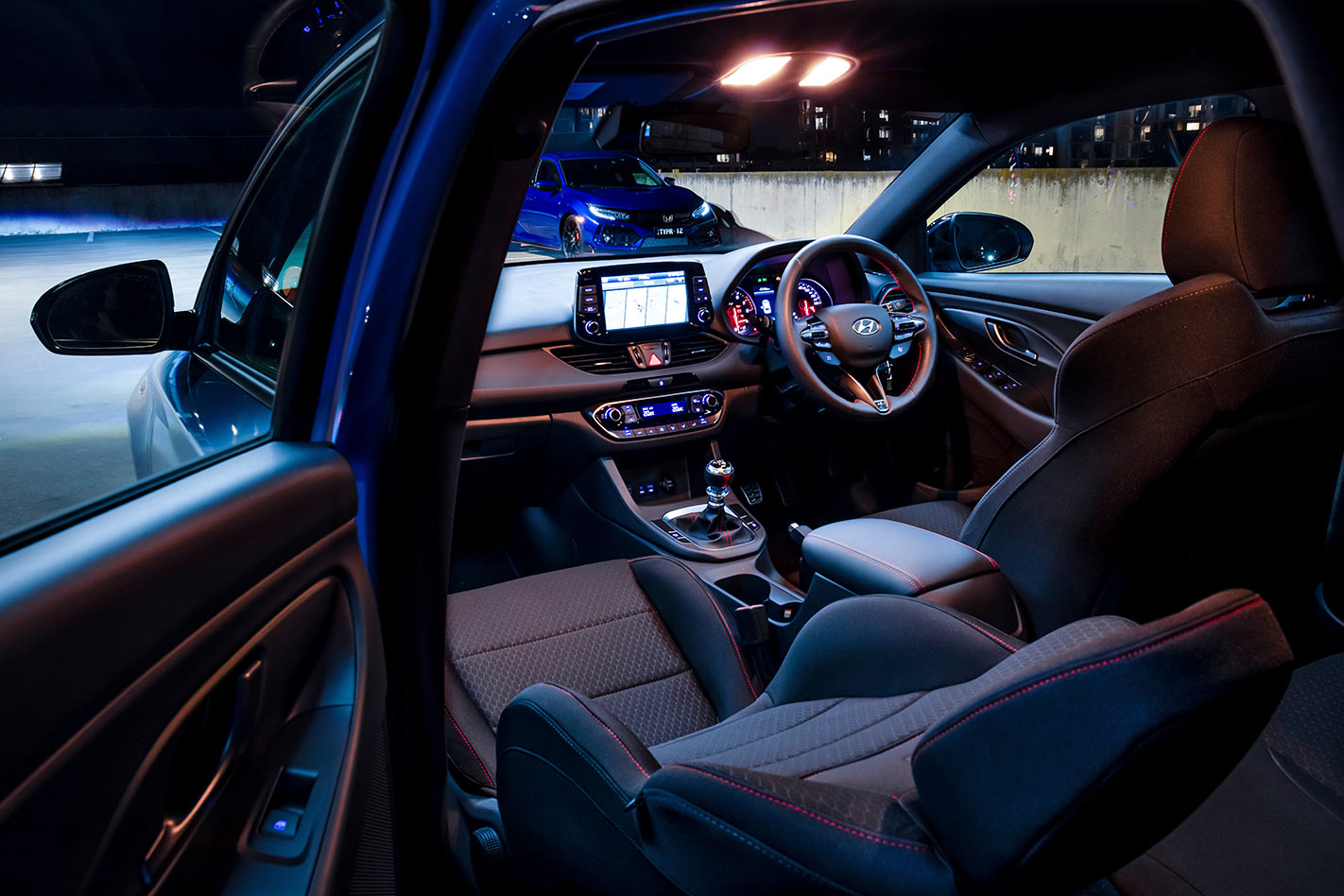
The Australian tune for the suspension stiffens the rear end in comparison to the front, making it feel more playful. While this affects primary ride compliance, you gain back in the way the car copes with low amplitude, high frequency secondary imperfections. It seems a reasonable payoff to accept the odd bump in order to feel more intimately connected to the road the rest of the time. The i30N is a great ‘seat of the pants’ hatch in that regard, but such is the easily configurable nature of its N Custom mode that I suspect that many will, for typically gnarly Australian hill routes, set the ride to Comfort and amp every other setting up to maximum angry.
After driving the Honda and Hyundai, the Focus ST feels a sizeable step behind on the Chum Creek test route. I refer back to my notes. “Compared to the others, the ST seems tall and narrow. The gearbox has the longest travel of the three. The side bolsters on the Recaro’s cushion collapse beneath your thighs mid-corner. The deep engine note with the five-pot sound-symposed warble is monotonous and makes it harder to drive by ear and sounds unrewarding to rev. The steering is hefty yet ultra-pointy, the brake pedal is hard and yet the throttle pedal feels as if it has very light springing to it. Needs customisable drive modes.” Hardly a ringing endorsement.
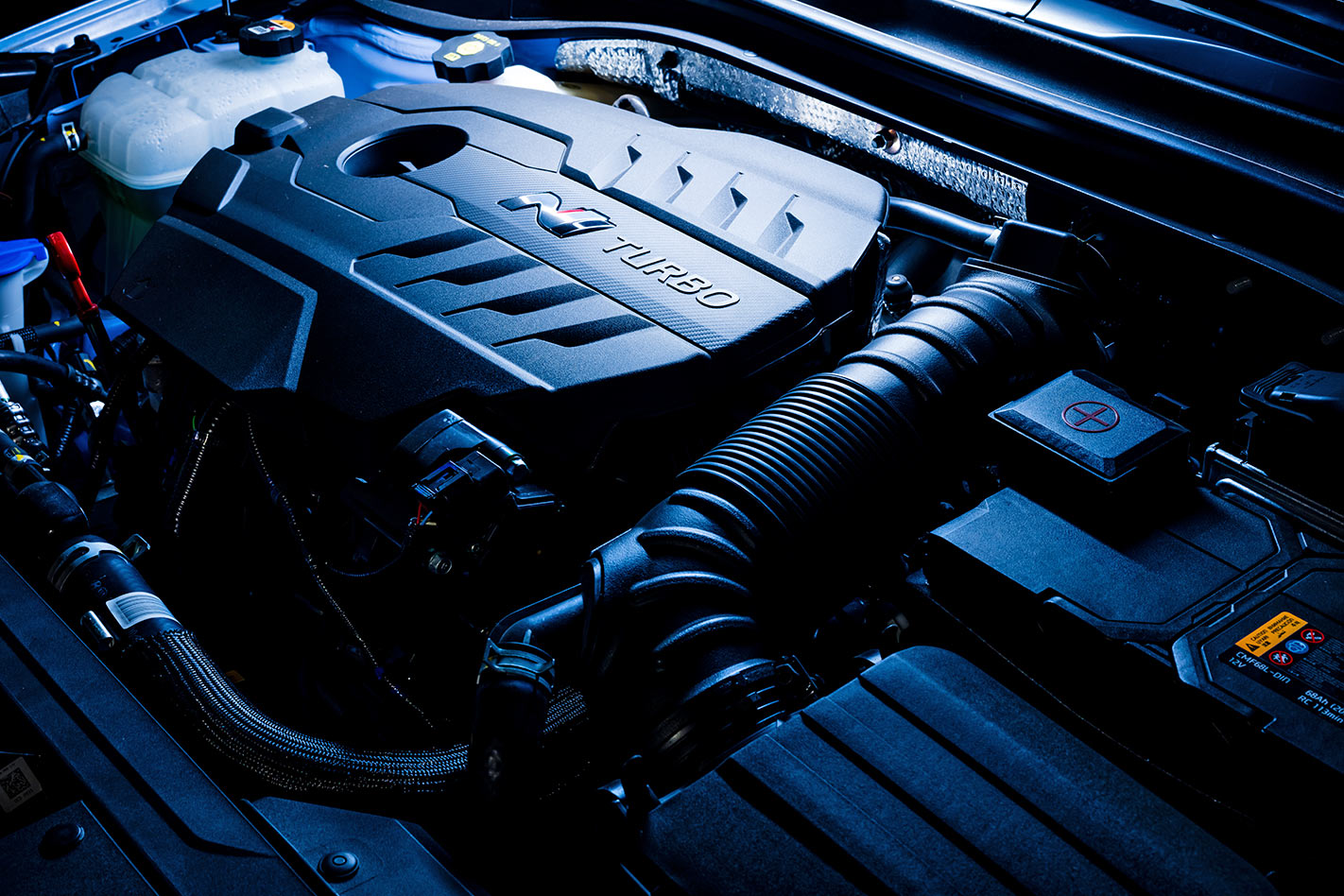
It’s fair to say that it’s initially underwhelming, in this company at least. Yet the more time spent with the Focus, the more enjoyable it becomes. The abundance of low-end torque makes it a joy to drive around town. It never feels tempted to stall as a result, unlike the finicky i30N. The pedal set-up that initially feels so weird allows you to trail brake into the apex and then gently angle your right foot onto the throttle, easing out of the middle pedal and onto the gas all in one roll of the ankle. It gives the Focus the most beautiful balance on corner exit, helped by the grip offered by its lightning quick clutch-actuated Borg-Warner developed e-LSD. This can lock to a 50:50 ratio of torque split across the front axle and do so predictively, making it faster in real-world scenarios than a traditional reactive helical mechanically locking differential. Doing everyday stuff like punting the Focus ST out of junctions, point and squirting it between turns and jinking it through roundabouts paints a huge grin on your face.
The Focus’ stability control calibration makes the Honda’s set-up feel a generation behind and the value of investing in the Michelin Pilot Sport 4S tyre pays back in spades, wet or dry. The damping is well-judged but one aspect of flicking the car into its Sport or Race Track modes is that the steering, which has a faster ratio than a Ferrari 488GTB, can feel a little contrived in its weighting. Yes, the ST has some flaws, but its playful personality, sensible ergonomics and accessible skillset might make it the most endearing of the three to live with.
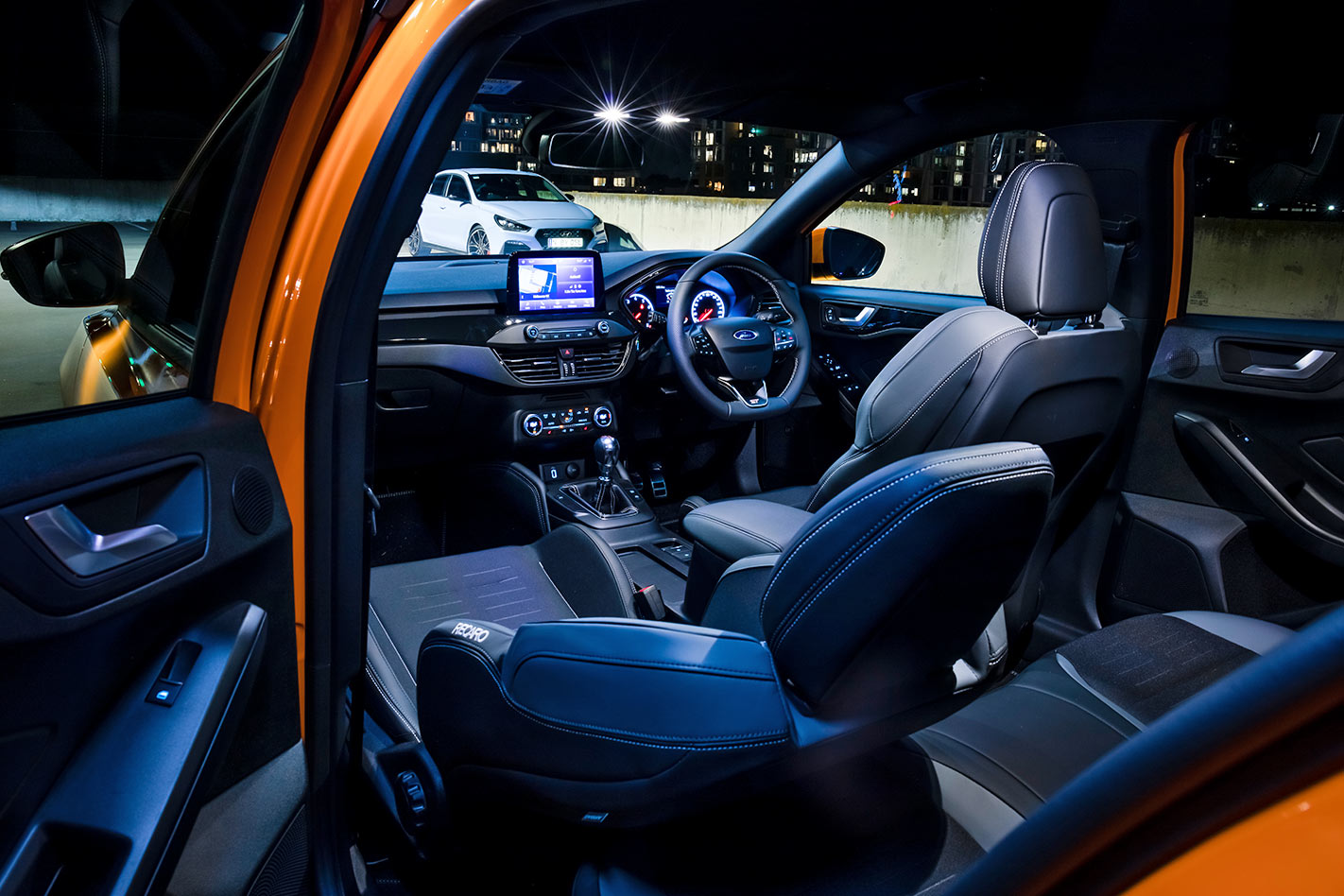
But it’s not the best. That’s something that the Honda and Hyundai get to duke out. In terms of pure dynamic talent, the Honda wins. It addresses the fundamentals of go, stop and steer more effectively and if a hot hatch can nail that brief, it’s always going to be extremely hard to beat. For purists, there’s no argument here. The Type R is uncompromising and, in certain regards, an absolute.
Broaden the discussion and take into consideration which is the best buy and the Hyundai sidles to the fore. It’s huge fun to drive, but it can also dial back the aggression when you want it to and it’s this versatility of character that make it such a formidable talent. When asked which of the three cars they’d buy with their own money, every single one of the road test trio pointed at the Hyundai.
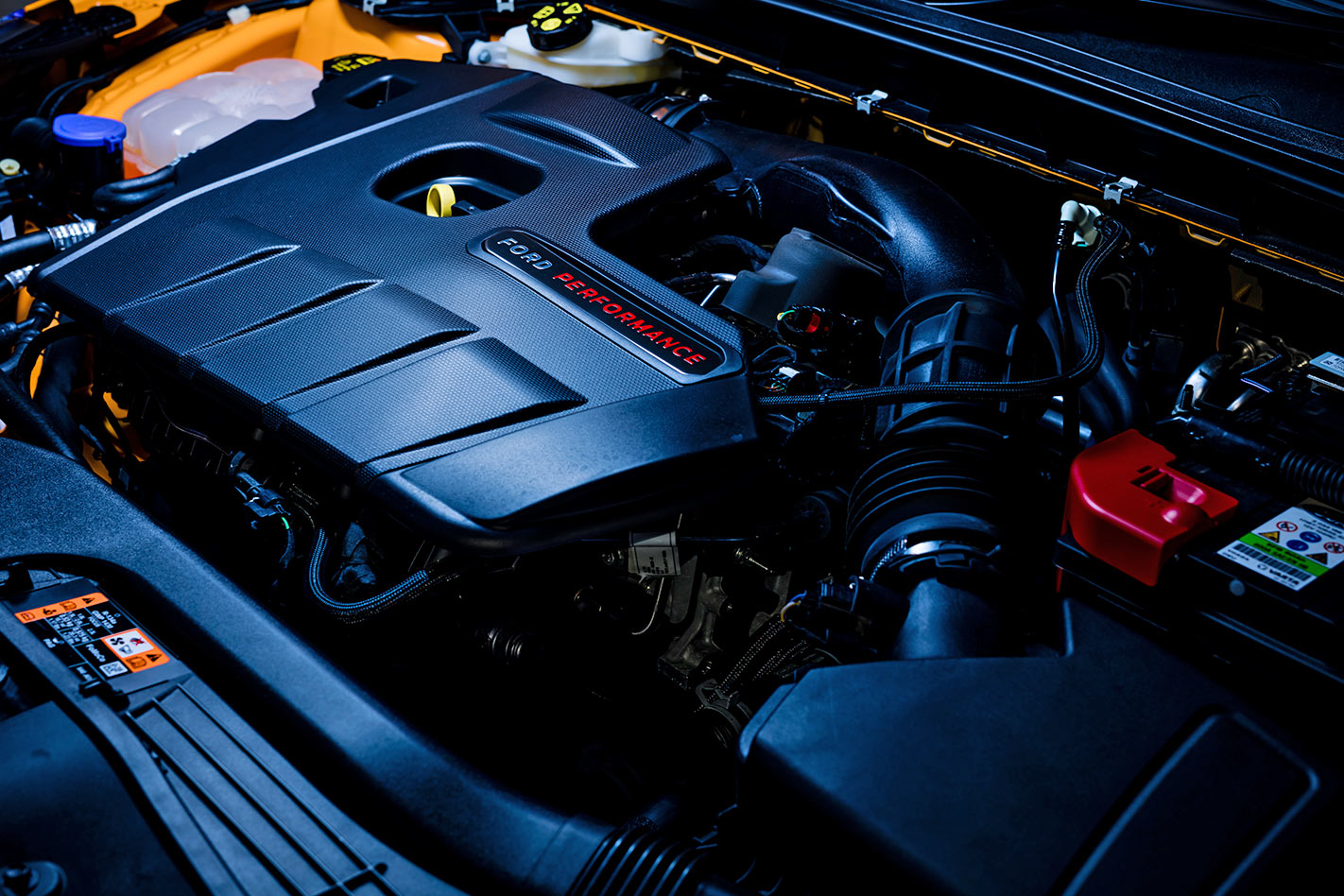
In truth, all three cars here are brilliant hot hatches. The Focus ST is a grower that channels muscle car character and fun-factor into a front-drive hot hatch. The Civic Type R is the destroyer, the car that will dismember the most challenging road you know. The cheapest, slowest car of the trio is the decathlete, the multi-talented one that offers the longest-lasting payoff. The Hyundai i30N occupied the top step of the podium back in 2018 and two years later it’s still there.
GOODBYE TO LAG
Another trick the Focus ST has up its sleeve is anti-lag. No, you’re not going to be shooting huge gouts of flame out of your tailpipes like Colin McRae on the Thousand Lakes, but the system will keep the throttle open to a degree, even upon lifting off the pedal. This tech, borrowed from the GT supercar, prevents compressor wheel stall and enables boost pressure to build quicker when the accelerator is re-applied.
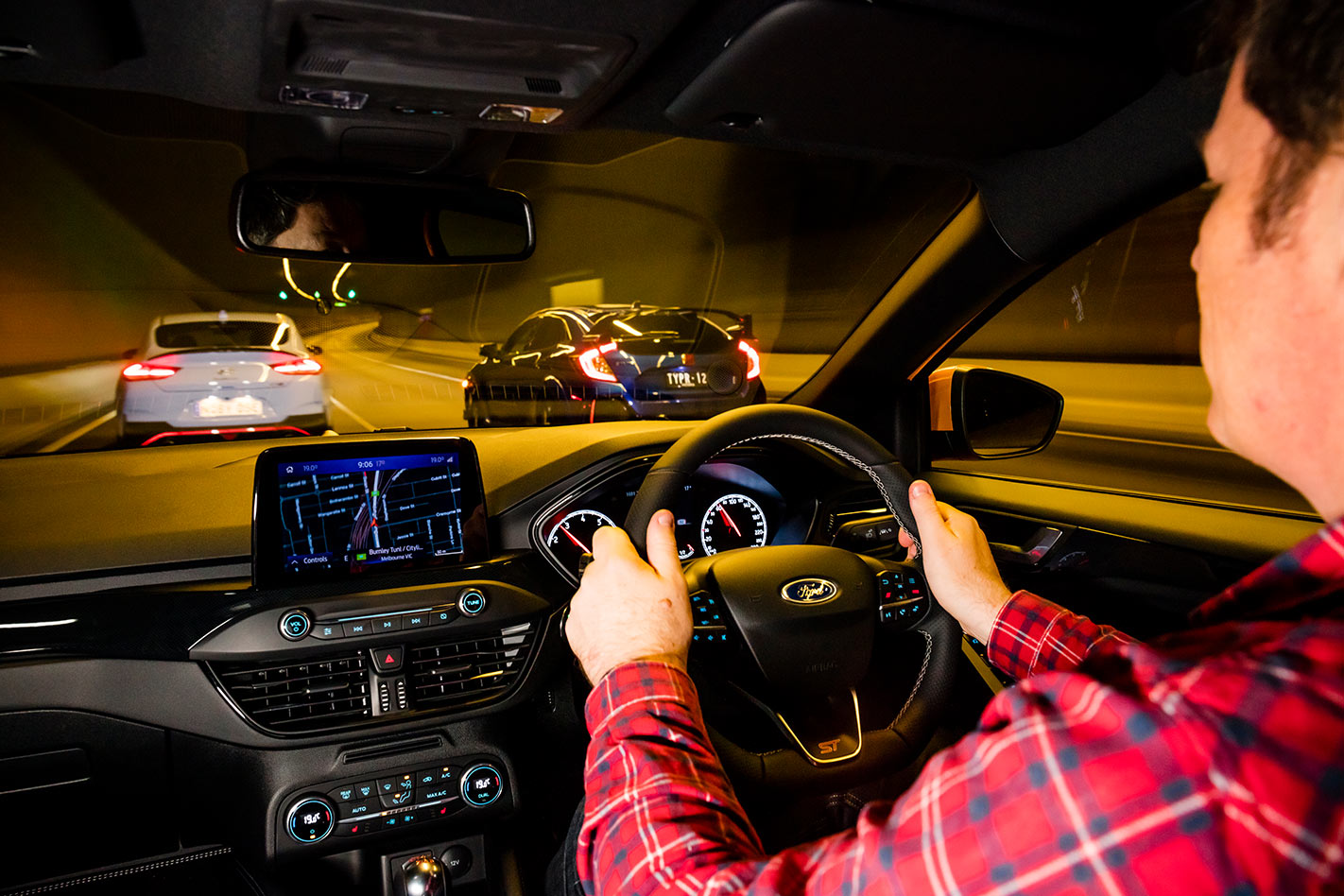
SHIFTY LIES
Conditions meant that we didn’t match Ford’s 5.7sec to 100km/h claim for the Focus, but there’s also a seven-speed automatic version of the ST on offer for an identical $44,690. You may well have seen reports claiming that it’s slower than the manual, recording a 6.0 second 0-100km/h time. That’s not the case. In the real world, the auto ST is within a tenth either way to 100km/h compared to the manual. We’d still stick with three pedals.
VERDICT
1st: Hyundai i30 N Fastback – 9.0/10
2nd: Honda Civic Type R – 9.0/10
3rd: Ford Focus ST – 8.5/10
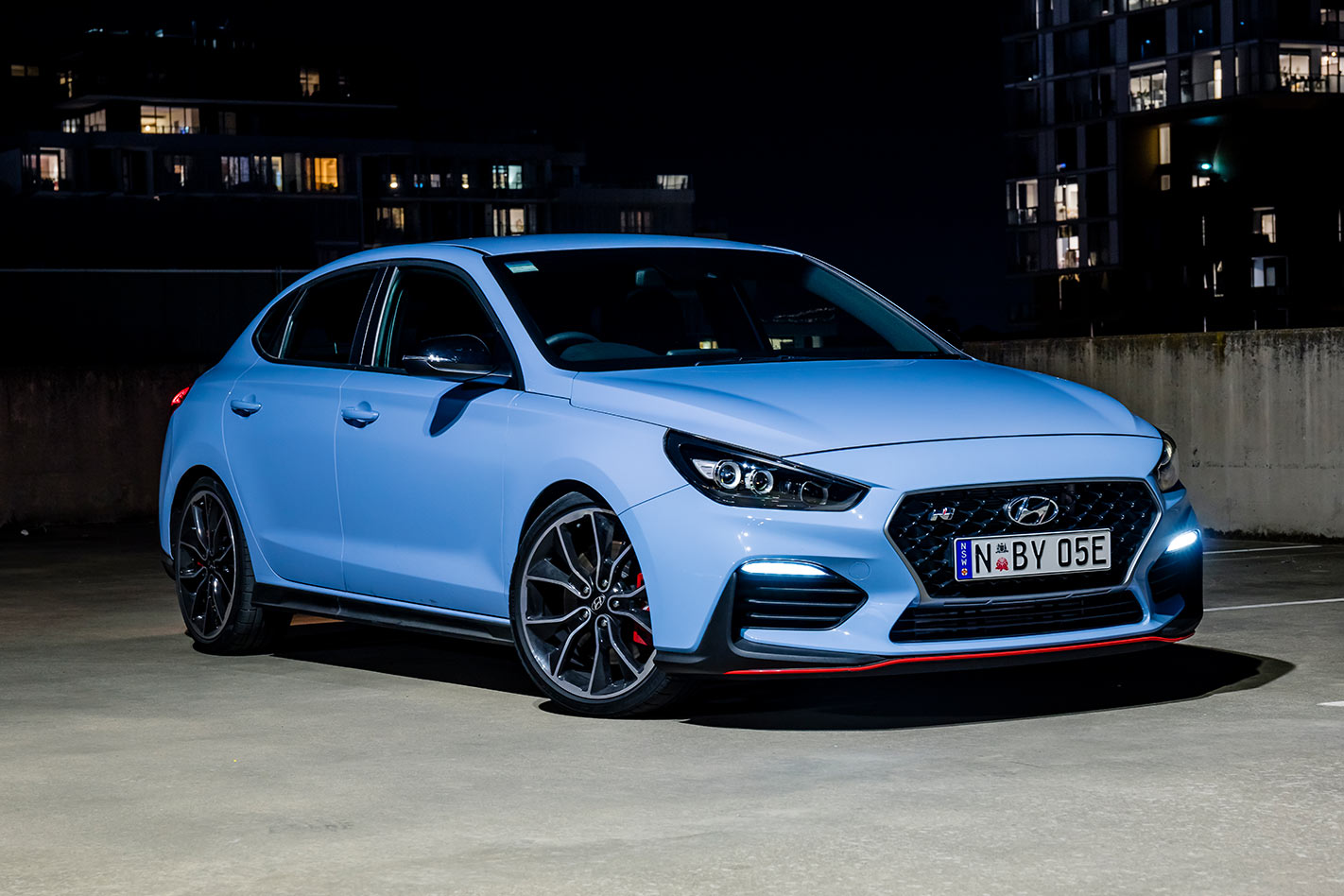
Hyundai i30 N Fastback specs
Price: $42,910 Engine: in-line 4cyl, dohc, 16v, turbo Layout: front engine (east-west), front drive Capacity: 1998cc Power: 202kW @ 6000rpm Torque: 353Nm @ 1450-4700rpm Gearbox: 6-speed manual Body: steel, 5 doors, 5 seats L/W/H/W–B: 4455/1795/1419/2650mm Track (F/R): 1556/1564mm Weight: 1441kg Boot: 436 litres Fuel/tank: 95 octane/50 litres Economy: 12.2L/100km (test average) Front suspension: struts, A-arms, coil springs, adaptive dampers, anti-roll bar Rear suspension: multi-link, coil springs, adaptive dampers, anti-roll bar Steering: electric rack-and-pinion Turn circle: 11.6m (2.2 turns lock-to-lock) Front brakes: ventilated discs (345mm) Rear brakes: ventilated discs (314mm) Tyres: Pirelli P Zero Tyre size: 235/35 R19 91Y Warranty: 5yr/unlimited km Service interval: 12 months/15,000km Glass’s 3-year resale: 58% AAMI Insurance: $914. 0-20km/h: 0.9sec 0-40km/h: 2.0sec 0-60km/h: 3.3sec 0-80km/h: 4.5sec 0-100km/h: 6.3sec 0-120km/h: 8.3sec 0-140km/h: 10.7sec 0-160km/h: 14.2sec 0-180km/h: 18.2sec 0-200km/h: 23.2sec 0-400m: 14.3sec @ 161.1km/h 80-120km/h: 3.8sec 100km/h-0: 35.9m Power-to-weight: 140kW per tonne Redline/cut-out: 6800/6800rpm Speed at indicated 100km/h: 97 Track: Heathcote Raceway, cold, damp, Temp: 9.0ºC Driver: Andy Enright
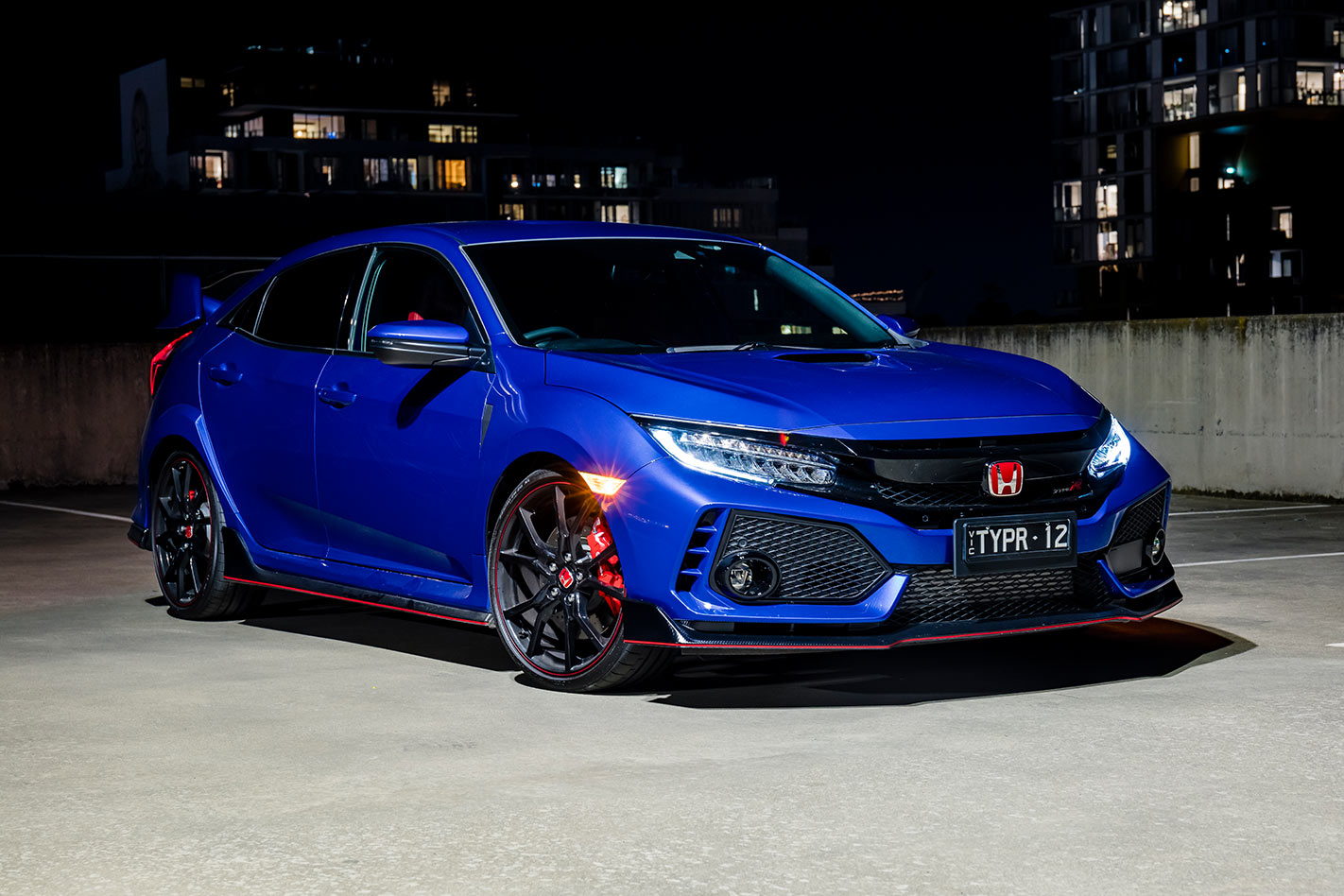
Honda Civic Type R specs
Price: $51,990 ($52,565* as tested) Engine: in-line 4cyl, dohc, 16v, turbo Layout: front engine (east-west), front drive Capacity: 1996cc Power: 228kW @ 6500rpm Torque: 400Nm @ 2500-4500rpm Gearbox: 6-speed manual Body: steel, 5 doors, 4 seats L/W/H/W-B: 4557/1877/1421/2700mm Track (F/R): 1599/1593mm Weight: 1396kg Boot: 414 litres Fuel/tank: 95 octane/47 litres Economy: 9.9L/100km (test average) Front suspension: struts, A-arms, coil springs, adaptive dampers, anti-roll bar Rear suspension: multi-link, coil springs, adaptive dampers, anti-roll bar Steering: electric rack-and-pinion Turn circle: 12.6m (2.2 turns lock-to-lock) Front brakes: ventilated discs (350mm) Rear brakes: solid discs (305mm) Tyres: Continental ContiSport Contact 6 Tyre size: 245/30 ZR20 90Y Warranty: 5yr/unlimited km Service interval: 12 months/10,000km. Glass’s 3-year resale: 55%. AAMI Insurance: $1024. *Options: Metallic paint ($575) 0-20km/h: 1.0sec 0-40km/h: 1.9sec 0-60km/h: 3.2sec 0-80km/h: 4.4sec 0-100km/h: 6.0sec 0-120km/h: 7.6sec 0-140km/h: 10.1sec 0-160km/h: 12.4sec 0-180km/h: 16.2sec 0-200km/h: 20.7sec 0-400m: 13.8sec @ 170.2km/h 80-120km/h: 3.2sec 100km/h-0: 35.5m Power-to-weight: 163kW per tonne Redline/cut-out: 7000/7000rpm Speed at indicated 100km/h: 94 Track: Heathcote Raceway, cold, damp, Temp: 9.5ºC Driver: Andy Enright
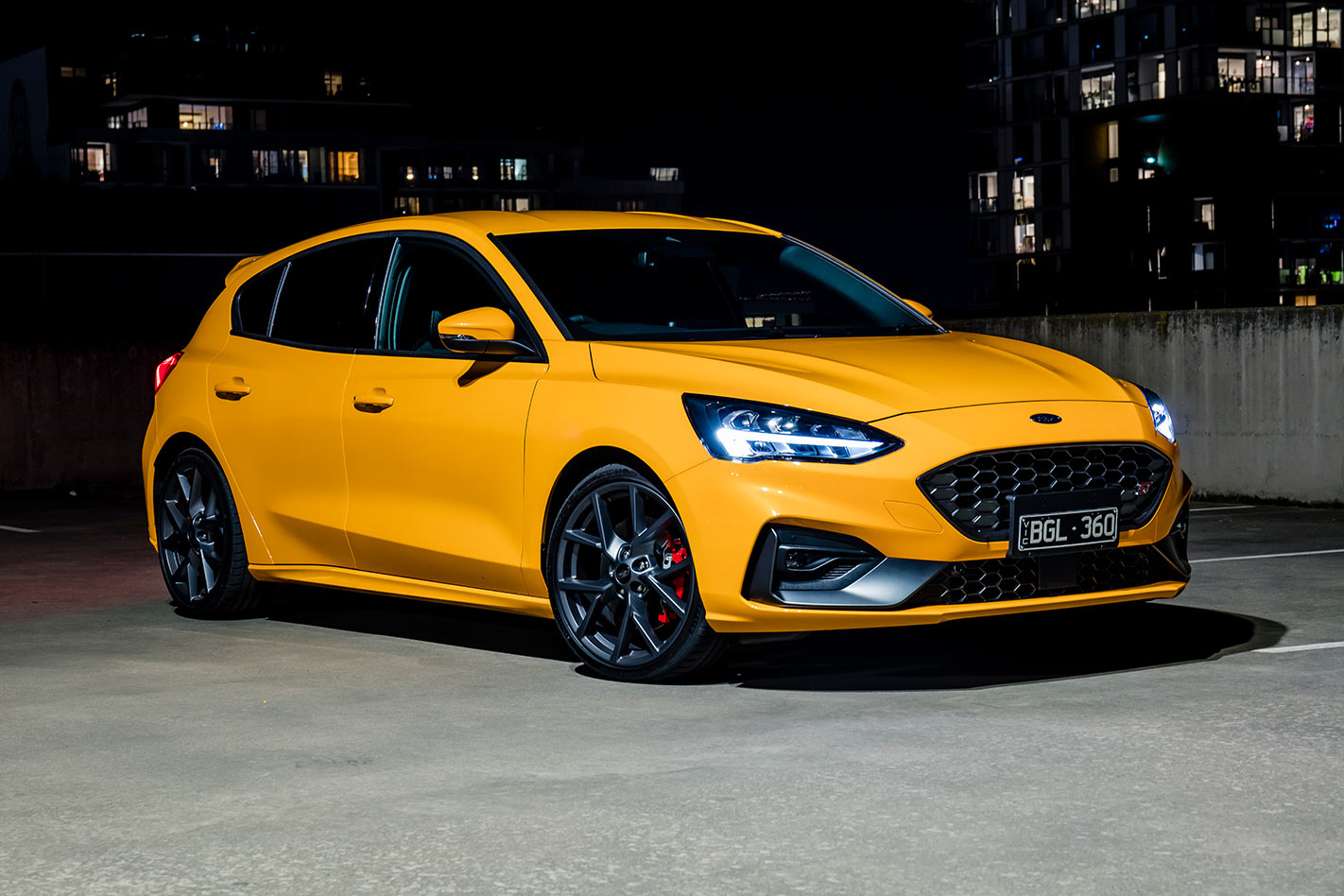
Ford Focus ST specs
Price: $44,690 ($45,340* as tested) Engine: in-line 4cyl, dohc, 16v, turbo Layout: front engine (east-west), front drive Capacity: 2261cc Power: 206kW @ 5500rpm Torque: 420Nm @ 3000-4000rpm Gearbox: 6-speed manual Body: steel, 5 doors, 5 seats L/W/H/W-B: 4388/1825/1458/2700mm Track (F/R): 1567/1556mm Weight: 1508kg Boot: 375 litres Fuel/tank: 95 octane/52 litres Economy: 10.9L/100km (test average) Front suspension: struts, A-arms, coil springs, adaptive dampers, anti-roll bar Rear suspension: multi-link, coil springs, adaptive dampers, anti-roll bar Steering: electric rack-and-pinion Turn circle: 11.3m (2.0 turns lock-to-lock) Front brakes: ventilated discs (330mm) Rear brakes: solid discs (302mm) Tyres: Michelin Pilot Sport 4S Tyre size: 235/35 ZR19 91Y Warranty: 5yr/unlimited km Service interval: 12 months/15,000km. Glass’s 3-year resale: NA%. AAMI Insurance: $945. *Options: Metallic paint ($650) 0-20km/h: 0.9sec 0-40km/h: 1.9sec 0-60km/h: 3.1sec 0-80km/h: 4.4sec 0-100km/h: 6.1sec 0-120km/h: 8.0sec 0-140km/h: 10.2sec 0-160km/h: 13.5sec 0-180km/h: 17.6sec 0-200km/h: 22.7sec 0-400m: 14.2sec @ 164.0km/h 80-120km/h: 3.6sec 100km/h-0: 37.1m Power-to-weight: 137kW per tonne Redline/cut-out: 6500/6600rpm Speed at indicated 100km/h: 95 Track: Heathcote Raceway, cold, damp, Temp: 10ºC Driver: Andy Enright


